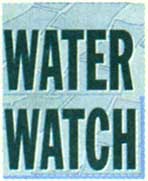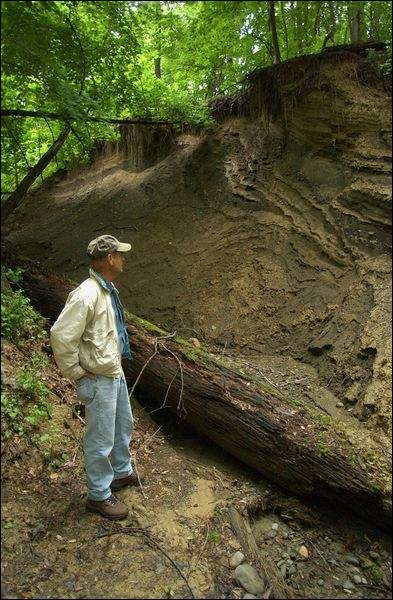
June 28, 2006
 An occasional series that looks at water issues in the region
An occasional series that looks at water issues in the region
Runoff alters landscape, leaves path of pollution
Erosion creates gully, damaging section of Greenway trail
By Dan Shapley
Poughkeepsie Journal

Kathy McLaughlin /Poughkeepsie Journal
Dick Lahey examines erosion on the Wappinger
Greenway Trail. The trail is closed because of
excessive erosion from stormwater runoff.
WAPPINGERS FALLS — Dick Lahey calls it the "Grand Canyon of New Hamburg."
No Wonder of the World, this one's a wonder of unintended consequences. It's a gully, really. A really deep gully.
When it rains, stormwater from a few dozen houses in a 50-year-old Town of Poughkeepsie development is channeled down drains and then diverted via a pipe into the woods. There, it has cut like the Colorado River, carving its way to Wappinger Creek.
As runoff has expanded the gully, it claimed a 15-foot footbridge on the Wappinger Greenway Trail. Then, it claimed the 25-foot bridge that replaced it. To replace the bridge now would take planks at least 40 feet long.
"We're concerned about liability. We don't want people to bushwhack around the erosion problem," said Dick Lahey, a member of the Wappinger Greenway Committee, as he stood at the top of the steep and unstable gully. Lahey is also a board member of the Putnam Highlands Audubon Society, which owned the soil that has since been washed into an ever-shallower bay of Wappinger Creek.
"This is the major impediment to creating the Greenway trail," he said. "This needs to be corrected or we have to find some way to go around it."
It's a textbook example of pollution that the so-called "Phase II" stormwater regulations of the Clean Water Act are designed to stop.
The Clean Water Act has curtailed pollution from pipes jutting from industries and sewage treatment plants, leading to dramatic increase in the nation's water quality.
But stormwater still carries oil — equivalent to 17 Exxon Valdez tankers spilling every year — into the nation's water. It washes away tons of topsoil. It is considered the No. 1 reason the most pristine Hudson Valley streams are in decline, and that badly polluted streams haven't recovered more.
Municipal officials in urban and suburban communities are scrambling to comply with the 2008 Phase II deadline to prevent erosion at small construction sites and to treat polluted stormwater from roads and parking lots. Tackling existing problems is required, "to the maximum extent practicable" — but the often expensive and complicated solutions are being treated with less priority than preventing future problems.
Pond to be built next year
It won't be until next year — five years after receiving a state grant — that Poughkeepsie and the Dutchess County Soil and Water Conservation District expect to build a settling pond and a landscaped terrace to reduce the velocity of the cascading water that slices through the trail. The cost: $268,000 from the 2002 grant — plus the labor of town highway crews and county soil and water technicians.
"Years ago, they'd just dump the water and go," Poughkeepsie Councilman Jay Baisley said. "Fifty years later, this is what happens. This is probably one of thousands in the county."
Whether they number in the dozens, hundreds or thousands will become clearer as the Soil and Water Conservation District completes a project to map all known stormwater outfall pipes, and then prioritize which pose the biggest problems. The project is part of the district's state-funded effort to train municipal workers, educate the public and provide technical assistance so towns can comply with the law.
"The main focus where they've really tried to direct us is to set up local laws such that you've got good erosion and sediment control at construction sites of one acre or more, and that there is good management and maintenance afterward," said Dave Kubek, a technician for the Soil and Water Conservation District.
Existing problems aren't hard to find. About a mile up the the creek from the washed-out trail, Vince Liardo watches Wappinger Lake swell with stormwater every time it rains. A maze-like network of underground pipes carries runoff from a long stretch of strip malls on Route 9 into the lake right next to the Lakehouse, Liardo's bait and tackle shop, where he rents boats to fishermen.
"You see how shallow that is?" he said, pointing to the lake bottom around the outfall. "That's all salt from Route 9."
Oil, road salt do damage
Besides road salt, the stormwater is most likely laced with other pollutants: Oils from cars, sewage from leaking or improperly connected sewers, restaurant grease from illegal or inadvertent dumping and the wild card — whatever anyone dumps on the street or down a storm drain. A cigarette butt tossed out the window near the Poughkeepsie Galleria will, most likely, end up on the bottom of Wappinger Lake.
Several years ago, all the water chestnuts near the pipe suddenly died, and have yet to grow back. Liardo can't prove it, but he believes it happened when contractors working at a nearby hazardous waste cleanup injected the groundwater with a reactive agent, causing pollution to bubble up into the storm drain, and then into the lake.
Whatever flows out of the pipe has never been tested for contaminants. Neither has the sediment.
Liardo said the Department of Environmental Conservation ag-reed to test the outfall as the owners of Nine Mall Plaza resume work on the next phase of that cleanup, which is addressing groundwater polluted by the dry cleaning solvent tetrachloroethylene.
Liardo and others are also concerned about a new development proposal that would turn a car dealership into another strip mall plaza on the shores of the lake in the Town of Wappinger. They fear stormwater runoff hasn't been adequately considered, especially since the lake is a designated critical environmental area, which means it requires additional consideration whenever a project may disturb it.
"That's probably the biggest threat to the lake — stormwater," said Tim Welling, a Dutchess Community College instructor who has worked with Liardo to study the lake.
Wappinger Lake points to other big challenges that will come with the new stormwater rules. Namely, the problem was already solved, once, and some money has been thrown at the problem without results.
A settling basin installed about 15 years ago proved inadequate to handle the runoff, and the Department of Transportation lacked the equipment to maintain it, said Ed Hoxsie, executive director of the Soil and Water Conservation District.
In 1998, the state put up $250,000 so county and local crews could replace the basin, but the project was held up, Hoxsie said, because there is neither enough money to pay private contractors, nor enough manpower from local agencies to do the work. Another state grant — $54,000 in 2002 to monitor storm drain outfalls and prioritize which to address — has yet to be implemented.
Installing and maintaining treatment systems is likely to become an increasingly hard and expensive job for municipal workers. Unless a homeowner association exists at a particular housing development, in most cases, Kubek said, towns will become responsible for maintaining stormwater management systems such as settling ponds that need periodic excavation. Without proper installation and maintenance, as the Wappinger Lake pipe shows, the systems can be rendered useless.
Stormwater that isn't managed is already causing problems with increasing frequency as development continues to alter the natural flow of rainwater into the ground and streams.
"It's coming up constantly," Baisley said. "I'd say three out of four calls I get are about drainage. There's no place for the water to go."
You can help decrease stormwater pollution
Stormwater pollution is sometimes referred to as "people pollution" because it results from the activities of countless people every day. Small amounts of pollution from across the landscape combine to create real problems downstream. Here are 5 steps you can take to help:
- Use nontoxic alternatives to common household products. Boiling water, or the foaming action of baking soda and vinegar, can work as well as chemical drain cleaners to unclog drains, for instance.
- Don't dump hazardous waste down the drain or outdoors. Both Dutchess and Ulster counties offer periodic hazardous household waste disposal days. For information, visit your county's Resource Recovery Agency at
www.dcrra.org
in Dutchess or
www.ucrra.org in Ulster.
- Don't dump car engine oil or other automotive fluids. It is illegal. Most service stations accept used oil.
- Choose non-phosphate detergents, and use sparingly, when washing your car. Consider using a commercial car wash that recycles its water.
- Plant your lawn and garden with native, drought-resistant plants. Reduce or eliminate the use of pesticides and fertilizers.
On the Web
Visit this Environmental Protection Agency Web site: www.epa.gov/region02/water/npspage.htm for more tips.
What's next
The Village of Fishkill and Dutchess County Soil and Water Conservation District will present an information session on stormwater and water pollution at 6:30 p.m. July 13 at the Fishkill village hall, 1095 Main St. Topics will include why stormwater control is a growing concern, what citizens can do to reduce water pollution, and what the new "Phase II" stormwater regulations mean for Dutchess County residents. For information, call 845-677-8011 ext. 3.
At a glance
Twelve of the 15 municipalities in southwestern Dutchess County have joined an intermunicipal working group on stormwater management organized by the Dutchess County Soil & Water Conservation District. The council has yet to formally meet. The City of Poughkeepsie, Town of Wappinger and Village of Wappingers Falls have not joined.
Copyright 2006, Poughkeepsie Journal. Reprinted with Permission.
www.poughkeepsiejournal.com

 An occasional series that looks at water issues in the region
An occasional series that looks at water issues in the region
